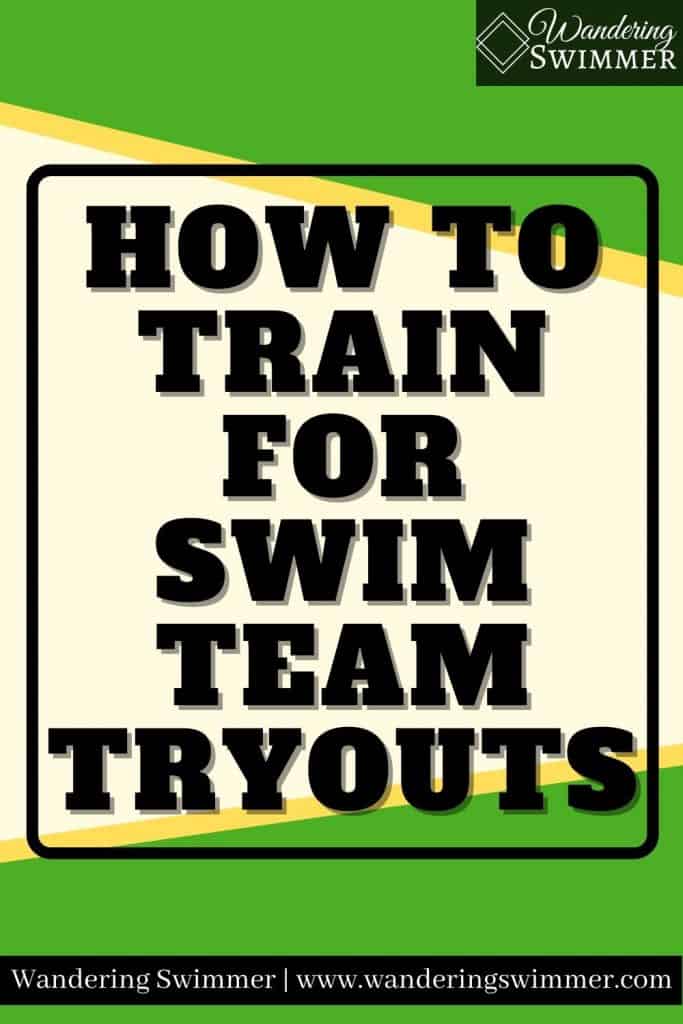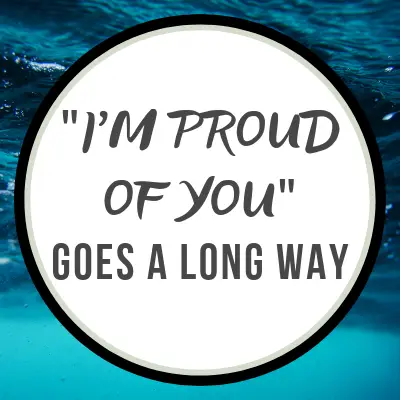If you’ve decided to join a swim team, you probably have to try out first. Tryouts can be stressful but the best way to have a successful tryout is to train for them.
Related articles:
And while training for swim team tryouts doesn’t guarantee that you’ll make the team, it can help increase your chances. And like many things in life, practice makes you better!
Ready to get started? Here’s how to train for swim team tryouts.
Disclosure: This post may contain affiliate links, meaning we earn a small commission at no cost to you if you purchase something through one of our links. As an Amazon Associate, we earn from qualifying purchases. Please check out our disclosure page for more information.

What to Expect at a Swim Tryout
Before you start to train for swim team tryouts, you need to know what’s expected at swim tryouts first.
This will vary by team, but, you can expect the coach to test your swimming skills at tryouts. Expect the coach to look at:
- How many of the four strokes can you complete?
- Can you do a flip turn?
- Do you know how to do an open hand turn?
- How does your start look?
- How much can you swim?
- Can you swim a certain distance/stroke in a predetermined time?
If you don’t know how to swim, you should consider taking lessons first with a qualified instructor or swim school. Rarely are swim teams a place to learn how to swim. To join a swim team, you usually need to know how to swim at a minimum.
Related article: A Quick Guide to Swim Lessons
How to Train for Swim Team Tryouts
Get Tryout Information From the Coach
Tryouts are the best way to place swimmers on the correct team. Whether that’s with the Jr. Varsity or Varsity team in high school or various program levels in year-round club swimming. Coaches know exactly what they’re looking for during tryouts.
That said, you should look to see if the team has the tryout requirements listed on their website. Some teams post this with other tryout information, such as suggested time standards for swimmers.
Related article: What Do Coaches Expect at Swim Tryouts?
If tryout information isn’t available online, talk to the coach directly, and write down the information.
Make sure you also find out when and where tryouts will be held. It doesn’t do you any good if you train for swim team tryouts only to miss them!
Start swimming!
Once you know for sure that you want to join a swim team and you know what’s required, start swimming! Find a pool that you can practice at and get to work training for your tryouts.
Related article: 10 Tips to Prepare for Swim Team Tryouts
No matter where you decide to swim, just make sure you start swimming. Doing this is better than sitting around and waiting for tryouts to happen. Plus, it helps build up confidence and makes you more able to meet expectations.
Stretch and Warm-Up
It’s incredibly easy to want to jump into the water and start swimming. But hold onto that desire for about twenty minutes or so.
Stretching before your workout is crucial to help avoid injury. Just as you would stretch before running or lifting, you should stretch before you start swimming too.
Swimming is highly repetitive in its motions, especially for your shoulders. Taking time to complete some dynamic stretching before getting into the pool can help lessen injuries.
Loosen your shoulders up with shoulder rotations, band work, and some jumping jacks. Do some slow squats to wake up your leg muscles and do some foot flexes to work your ankles.
And once you’re in the water, make sure you warm up properly. Do some easy laps to get your muscles loose and warm. Then work on your kick and pull individually. Doing all this will get your body ready for your workout.
Plus, it’ll help you learn what swim teams do at practice 🙂
Find Your Base Ability
Swimming is difficult if you haven’t trained or practiced frequently. As you start to train for swim team tryouts, find how much swimming you can do in one workout session.
As a note, please remember that you should stop occasionally to get something to drink and to rest. Swimmers rarely train an entire practice without stopping.
If you find that you can swim twenty laps of the pool in thirty minutes, that’s okay! You know where you’re at and what to work on.
Try to swim daily, if possible. Each time you go back to the pool, try to add another lap or two. Or see if you can get faster at swimming the same amount of laps. Do both if you’re feeling good!
You’ll also want to see what your base swimming ability is in comparison to what’s required at tryouts. If you’re expected to swim a 50 freestyle in 45 seconds, see where you’re at and work to get better at it.
Work on Your Cardio Endurance
It’s easy to build up your cardio endurance on land. Doing things such as jogging, running, or biking are all great ways to build up your cardio.
Cardio endurance in the water though is a completely different game. Mainly because you have to hold your breath while working out. And it makes for a much more difficult workout.
To build up your cardio endurance, keep working out in the pool. Try to add more laps to your workouts each week. If you can’t add a lap each day, that’s okay! Adjust so that you add a new lap each week instead.
Gradually increasing the distance that you swim is the best way to work on your cardio endurance. It’s how competitive swimmers train, too, after they’ve been out of the water for an extended break.
Related article: How to Return to the Pool After a Long Break
If possible, try to increase the amount of time you’re in the water, too. Add an extra five or ten minutes in the water each week. Or every two weeks. This will build up your endurance and strength in the water!
The key is to not rush the process. It takes time for your muscles and cardio system to adjust to swimming.
Practice the Various Strokes
Depending on the team you’re trying out for, you may have to show some basic skills in all four strokes. Coaches might not expect mastery in them based on the team, but they might still look for an understanding in each of them.
The four competitive strokes in swimming are:
- Butterfly
- Backstroke
- Breaststroke
- Freestyle
Freestyle and backstroke are probably the easiest for newer swimmers. And freestyle is the stroke used most frequently at practice. Whereas breaststroke and butterfly are a bit more challenging.
Don’t let that stop you though!
If you can, have another swimmer watch your strokes and ask for their advice. You can also look at hiring a personal coach for a few weeks to help you get the basics down.
Try this workout to help you work the competitive strokes.
- 12x25s
- Each 25 is a different stroke, in the order as listed above
- You’ll go through each stroke 3 times
- 20-25 seconds rest (or as needed) after each 25
Train in the Proper Gear
Before you start training for swim tryouts, you should make sure you have the proper gear. This means that you have a swimsuit and goggles at a minimum.
Some will argue that you don’t need a cap. Our two cents on the subject is that you should wear one. Swim caps help keep hair out of your eyes when swimming and most importantly, it keeps it out of the water.
Related articles:
- 6 Reasons You Should Wear a Swim Cap
- Your Quick Guide to Swim Caps
- 7 Reasons to Wear Goggles When You Swim
- How to Pick the Right Swim Goggles
We also recommend that you don’t attempt to swim in shorts and a t-shirt.
They become heavy once in the water and make it difficult to swim in. If you feel more comfortable in a shirt, then consider swimming in a rash guard or swim shirt instead.
Rash guards and swim shirts fit tighter to the body and are made of lighter material. This makes it easier to swim in and won’t weigh you down as much.
Find more information about rash guards and why you should wear them in our article: Answering Your Questions About Rash Guards
Talk to Someone on the Team
If you can, talk to someone on the team and ask if they can help you train. They know the types of workouts that you’ll do and what’s expected. They can also give you advice in terms of swim practice etiquette, words you’ll hear at practice, and what really happens at swim practice.
You should, however, take any advice with some caution.
What one swimmer might consider ‘easy’ could actually be challenging for you. Ask a current swimmer how long they’ve been swimming and what their times are in their events.
This can help you gauge their skill set to yours.
Stay Positive
Lastly, stay positive as you train for swim team tryouts.
You’re not going to learn everything overnight and some strokes might be more difficult for you than others. At the same time, you have to remember that building up your endurance takes time.
It’s not an easy thing to do, we’ll be the first to admit it. It’s hard work and when it doesn’t come easily or quickly, it’s tempting to give up.
But keep working at it. You’ll find that you’ve probably come far further than you realize. And you should take pride in that! Compare where you were at the start of your training to where you finish.

Everyone progresses at different speeds. What you might excel in, someone else might struggle with. And vice versa. For this purpose, it’s important that you only look at your own results and progress.
Related article: How to Calm Down Before Swim Tryouts
Looking at someone else and comparing yourself to them will only lead to disappointment if you’re not careful.
So relax and take in a deep breath. You’ve got this!
Best of luck! And as always, to happy swimming.
-Chevron
Bonus Content:
What to Look for in a Swim Team: How do you find the best swim team? When it comes time to look for a swim team, choosing the right swim depends mainly on: what do you want?
What are the 5 Basic Swimming Skills?: coming soon

Want to Improve at the Pool?
Join swimmers and swim parents to receive my free newsletter and receive a free Swimming Glossary e-book as a thanks!
Every month you’ll receive tips and coaching to help you find success at the pool.